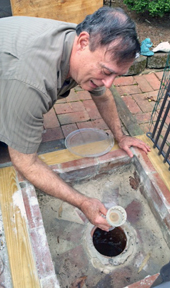
This photo was taken of the wine and the qvevri. The wine spent the last two weeks in a carboy settling.
Two weeks ago Kathy and I racked our wine out of our buried qvevri. The wine was cloudy and the skins had not dropped from the surface. My theory was that the wine was in a constant state of motion while in the qvevri. A day after racking into a three-gallon glass carboy, there was a layer of sediment on the bottom. After two weeks, I decided to rack the wine into a new carboy. The sediment reminded me of dead yeast cells. There were also some very small specks of skin from the grapes. Since I had an extra quart of wine, I was able to rack and full three gallons and had some left over for tasting.
This qvevri wine was made with Muscat grapes sourced from Lodi, California. It was a cloudy yellow color. The aroma was very floral with some orange blossoms. Orange was predominant on the taste. The wine was full bodied, one of the first signs that it spent time (six months) on the skins. Other wines that I have had made with Muscat grapes were lighter bodied than this qvevri wine. There was a faint trace of tannins. The wine had a long aftertaste and a bit of alcohol heat. It has 14% alcohol.
If I were to make this wine again, I would put some stems in the qvevri. I have been told that the stems will help with settling within the qvevri as well as add some tannins to the wine. I enjoy tannins in a wine. My next qvevri wine will be made with whatever grapes I can source locally. I am considering Viognier, but would also investigate if I can get some Rkatsiteli. There is a grower in Virginia growing Rkatsiteli. My reaction to our first qvevri wine is that it is OK, but can be improved. Looking forward to this year’s harvest and some locally sourced grapes.
Cheers,
Terry



How many percent of skins do you had in Qvevri.. ? next year if you find Rkastiteli or Saperavi try to make with 100% skins, stems and you will see how good wine it will be made.. .
60% to 70% skins with no stems. Yes I will include stems and more skins with this years vintage.